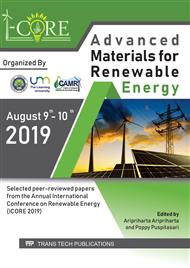[1]
BPPT, Outlook Energy Indonesia 2018, Badan Pengkajian dan Penerapan Teknologi (BPPT), (2018).
DOI: 10.14203/icdi.v4i.81
Google Scholar
[2]
S. Yokoyama, Buku Panduan Biomassa Asia Panduan untuk Produksi dan Pemanfaatan Biomassa The Japan Institute of Energy, The Japan Institute of Energy, Jepang, (2008).
Google Scholar
[3]
K.K. dan P.R. Indonesia, Kementerian Kelautan dan Perikanan Republik Indonesia, Https://kkp.go.id/ (2017).
Google Scholar
[4]
Sukarni, Sudjito, N. Hamidi, U. Yanuhar, I.N.G. Wardana, Potential and properties of marine microalgae Nannochloropsis oculata as biomass fuel feedstock, Int. J. Energy Environ. Eng. 5 (4) (2014) 279–290.
DOI: 10.1007/s40095-014-0138-9
Google Scholar
[5]
Prambada, Karakteristik Dekomposisi Pembakaran Bahan Bakar Campuran Mikroalga Spirulina Platensis Dengan Kulit Kacang Tanah, Universitas Negeri Malang, (2016).
Google Scholar
[6]
Sukarni, Sudjito, N. Hamidi, U. Yanuhar, I.N.G. Wardana, Thermogravimetric kinetic analysis of Nannochloropsis oculata combustion in air atmosphere, Front. Energy 9 (2) (2015) 125–133.
DOI: 10.1007/s11708-015-0346-x
Google Scholar
[7]
M. Jia, B. Fong, A. Chun, M. Loy, B. Lai, F. Chin, M.K. Lam, S. Yusup, Z.A. Jawad, Catalytic Pyrolysis of Chlorella Vulgaris : Kinetic and, Bioresour. Technol. (2019) 121689.
DOI: 10.1016/j.biortech.2019.121689
Google Scholar
[8]
R. López, C. Fernández, X. Gómez, O. Martínez, M.E. Sánchez, Thermogravimetric analysis of lignocellulosic and microalgae biomasses and their blends during combustion, J. Therm. Anal. Calorim. 114 (1) (2013) 295–305.
DOI: 10.1007/s10973-012-2843-z
Google Scholar
[9]
Y.A. Cengel, M.A. Boles, Thermodynamics An Engineering Approach, (2015).
Google Scholar
[10]
S.R. Naqvi, R. Tariq, Z. Hameed, I. Ali, W. Chen, S. Ceylan, H. Rashid, J. Ahmad, S.A. Taqvi, Pyrolysis of high ash sewage sludge: kinetics and thermodynamic analysis using Coats-Redfern method, Renew. Energy (2018).
DOI: 10.1016/j.renene.2018.07.094
Google Scholar
[11]
S.H. Kim, Investigation of Thermodynamic Parameters in the Thermal Decomposition of Plastic Waste - Waste Lube Oil Compounds, Environ. Sci. Technol 44 (13) (2010) 5313–5317.
DOI: 10.1021/es101163e
Google Scholar
[12]
Q. Wang, W. Zhao, H. Liu, C. Jia, H. Xu, Reactivity and Kinetic Analysis of Biomass during Combustion, Energy Procedia 17 (2012) 869–875.
DOI: 10.1016/j.egypro.2012.02.181
Google Scholar
[13]
S. Shawalliah, N. Abd, K. Ismail, Bioresource Technology Combustion characteristics of Malaysian oil palm biomass , sub-bituminous coal and their respective blends via thermogravimetric analysis ( TGA ), Bioresour. Technol. 123 (2012) (2012) 581–591.
DOI: 10.1016/j.biortech.2012.07.065
Google Scholar
[14]
K. Acikalin, Pyrolytic characteristics and kinetics of pistachio shell by thermogravimetric analysis, J. Therm. Anal. Calorim. 109 (1) (2012) 227–235.
DOI: 10.1007/s10973-011-1714-3
Google Scholar
[15]
S. Sumarli, C. Upendra, S. Bandhana, K. Himawan, Physicochemical Characteristics of Corn Silk as Biomass Fuel Feedstock, 515 (2019) 1–5.
DOI: 10.1088/1757-899x/515/1/012103
Google Scholar
[16]
Y. Xu, B. Chen, Bioresource Technology Investigation of thermodynamic parameters in the pyrolysis conversion of biomass and manure to biochars using thermogravimetric analysis, Bioresour. Technol. 146 (2013) 485–493.
DOI: 10.1016/j.biortech.2013.07.086
Google Scholar
[17]
L. Huang, J. Liu, Y. He, S. Sun, J. Chen, J. Sun, K.L. Chang, J. Kuo, X. Ning, Thermodynamics and kinetics parameters of co-combustion between sewage sludge and water hyacinth in CO2/O2atmosphere as biomass to solid biofuel, Bioresour. Technol. 218 (2016) 631-642.
DOI: 10.1016/j.biortech.2016.06.133
Google Scholar
[18]
A.A.D. Maia, L.C. de Morais, Kinetic parameters of red pepper waste as biomass to solid biofuel, Bioresour. Technol. 204 (2016) 157–163.
DOI: 10.1016/j.biortech.2015.12.055
Google Scholar


